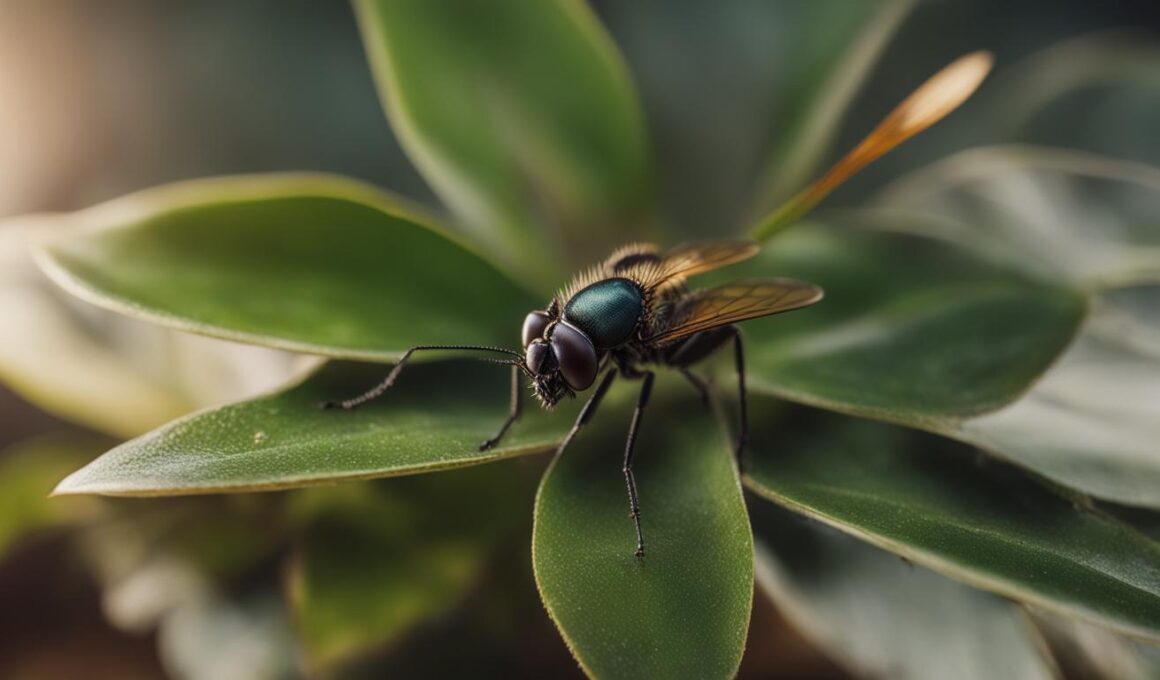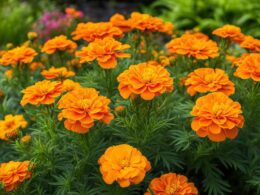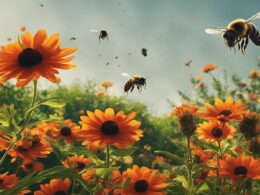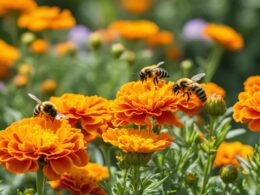If you notice small insects flying around your houseplants, it’s likely you have a fungus gnat issue. While the adults themselves aren’t harmful, the larvae they produce can damage your plants. Preventing infestations and getting rid of gnats is crucial to maintaining healthy indoor plants.
Post Summary:- Gnats in your houseplants are usually fungus gnats, and their larvae can harm your plants.
- Preventing infestations is important for maintaining healthy indoor plants.
- Inspect new plants, check for signs of gnats, and quarantine new plants before introducing them to your collection.
- Use sticky traps or make an apple cider vinegar trap to catch gnats.
- Adjust your watering schedule and consider using hydrogen peroxide solution to kill larvae in the soil.
Understanding Fungus Gnats and Their Impact
If you’ve noticed small black flying insects around your houseplants, chances are you have a fungus gnat infestation. These pests make their home in the moist soil of indoor plants and can have a negative impact on plant health. While the adults themselves are relatively harmless, it’s the larvae that can cause problems.
Fungus gnat larvae feed on organic material in the soil and the roots of plants. This can lead to reduced nutrient uptake and result in yellowing leaves, stunted growth, and overall weakened plant health. If left untreated, a gnat infestation can significantly damage your beloved houseplants.
To effectively combat fungus gnats and protect your plants, it’s essential to understand their life cycle and the potential consequences of an infestation. By taking proactive measures, you can ensure the health and vitality of your indoor greenery.
Impact of Fungus Gnats on Plant Health
Gnat larvae in the soil can have a detrimental effect on plant health. As they feed on organic matter and plant roots, they compromise the root system’s ability to absorb essential nutrients. This nutrient deficiency can manifest as yellowing leaves, as the plants are unable to produce chlorophyll effectively. Yellowing leaves are an early warning sign of a gnat infestation and should not be ignored.
In addition to nutrient deprivation, the physical damage caused by gnat larvae can weaken plants, making them more susceptible to other pests and diseases. The compromised roots may also result in poor water uptake, leading to dehydration and further stress on the plant.
Understanding the impact of fungus gnats on plant health is crucial in implementing effective prevention and control measures. By recognizing the signs of an infestation and taking prompt action, you can protect your houseplants and maintain their optimal growth and vitality.
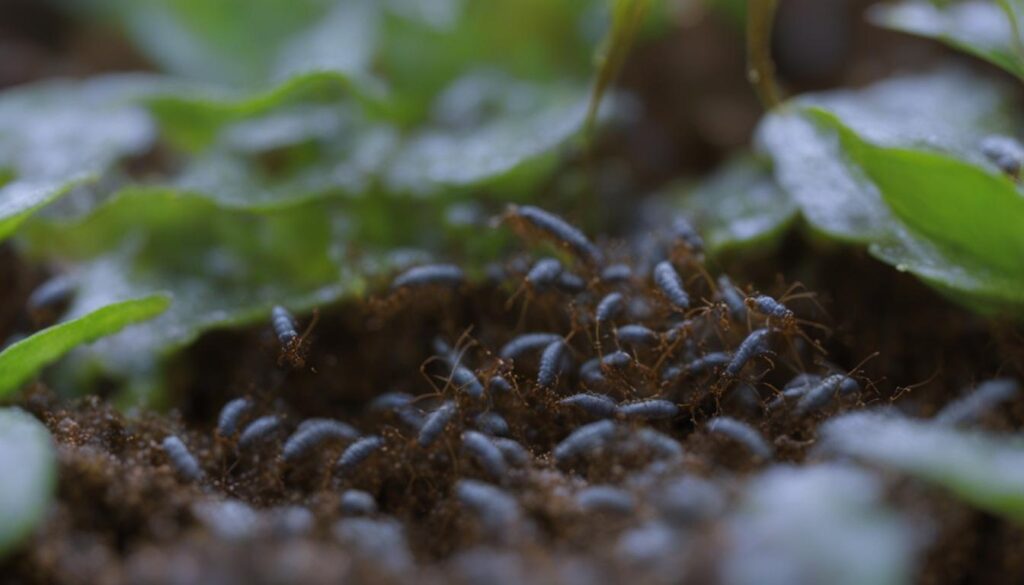
Prevention Tips for Gnat Infestations
If you want to keep your houseplants free from gnat infestations, it’s important to take proactive measures. By following these prevention methods, you can greatly reduce the risk of gnats finding their way into your plants.
Checking New Plants
Before introducing new plants to your collection, it’s essential to inspect them for any signs of gnats. Give the pot a gentle tap to see if any small flying insects emerge. Additionally, examine the potting mix for any signs of gnats or their larvae. This step can help prevent introducing an infested plant to your indoor garden.
Soil Drainage and Watering Habits
Gnats thrive in moist conditions, so it’s crucial to ensure proper soil drainage to discourage their presence. Overwatering your plants can create an environment that is ideal for gnat infestations. Check the moisture levels in the soil regularly and only water when necessary. Avoid letting water sit in saucers or trays, as this can attract gnats to your plants.
Quarantine and Monitor
When bringing new plants into your home, it’s a good practice to quarantine them for a period of time before integrating them with your existing plants. This allows you to closely monitor the new plant for any signs of gnats or other pests. By isolating the plant, you can prevent the spread of infestations to your other houseplants.
| Prevention Methods | Description |
|---|---|
| Inspecting new plants | Check for signs of gnats and larvae before introducing new plants to your collection. |
| Proper soil drainage | Ensure that your pots have adequate drainage to prevent the accumulation of excess moisture. |
| Moderate watering | Avoid overwatering your plants, as this creates a hospitable environment for gnats. |
| Quarantine new plants | Isolate new plants for a period of time to monitor for any signs of infestation before integrating with existing plants. |
By implementing these prevention tips, you can minimize the risk of gnat infestations and keep your houseplants thriving. Remember to regularly inspect your plants and take prompt action if you spot any signs of gnats or other pests. With proper care and attention, you can enjoy a healthy indoor garden free from the nuisance of gnats.
Natural Methods to Get Rid of Gnats
If you’re dealing with a gnat infestation in your houseplants, there are several natural methods you can try to eliminate these pesky insects. One effective method is to use sticky traps, which can be purchased from gardening stores or easily made at home. Simply place these traps near your plants, and the gnats will be attracted to the sticky surface and get trapped.
Another natural solution is the apple cider vinegar trap. Gnats are attracted to the scent of apple cider vinegar, so you can create a trap by filling a small container with apple cider vinegar and covering it with plastic wrap. Poke small holes in the plastic wrap to allow the gnats to enter. They will be attracted to the vinegar and become trapped inside.
| Natural Methods | Effectiveness |
|---|---|
| Sticky traps | Highly effective in trapping adult gnats |
| Apple cider vinegar trap | Attracts and traps adult gnats |
Adjusting your watering schedule is another way to deter gnats. Overwatering can create a moist environment that gnats thrive in, so make sure to let the top inch of soil dry out before watering again. This will help create an unfavorable environment for gnats to lay their eggs and prevent gnat larvae from developing.
If you want to target gnat larvae in the soil, a hydrogen peroxide solution can be effective. Mix two parts water with one part hydrogen peroxide and pour it into the pot. The solution will kill the larvae and prevent future infestations. However, it’s important to use this method sparingly, as hydrogen peroxide can also harm the roots of your plants if used excessively.
In conclusion, using natural methods such as sticky traps, apple cider vinegar traps, adjusting your watering schedule, and using a hydrogen peroxide solution can help you get rid of gnats in your houseplants. These methods are safe and effective alternatives to chemical solutions, giving you peace of mind while maintaining healthy indoor plants.
Chemical Solutions for Gnat Infestations
If natural methods aren’t effective in eliminating the gnat infestation in your houseplants, there are chemical solutions available that can help you get rid of these pests. These insecticidal sprays are specifically designed to kill adult gnats and can be used indoors to target the infestation directly. Make sure to follow the instructions on the product label for safe and effective use.
“Using insecticidal sprays can be an effective way to control gnat populations in your houseplants. Look for products that are labeled for indoor use and specifically mention gnat control. Follow the instructions carefully to apply the spray to the affected plants and their surrounding areas.”
Another chemical solution that can be effective against gnats is neem oil. Neem oil is derived from the neem tree and has insecticidal properties. It can be applied to the soil to kill gnat larvae and also used as a spray to target adult flies. Neem oil works by disrupting the feeding and reproductive activities of the gnats, ultimately leading to their eradication. Apply neem oil according to the instructions on the product label, ensuring thorough coverage of the affected plants.
Bacillus thuringiensis israelensis (Bti) is a bacterium that is commonly used to control mosquito larvae but can also be effective against gnat larvae. Bti is available in granule or powder form and can be mixed with water to create a drench that can be poured into the potting soil to kill gnat larvae. Follow the recommended dosage instructions on the product label for optimal results.
| Chemical Solutions for Gnat Infestations | Product | Application |
|---|---|---|
| Insecticidal sprays | Product A | Indoor use, specifically labeled for gnat control |
| Product B | Indoor use, specifically labeled for gnat control | |
| Product C | Indoor use, specifically labeled for gnat control | |
| Neem oil | Product D | Applied to soil or used as a spray |
| Product E | Applied to soil or used as a spray | |
| Product F | Applied to soil or used as a spray | |
| Bacillus thuringiensis israelensis (Bti) | Product G | Mixed with water to create a drench |
| Product H | Mixed with water to create a drench |
Tips for Outdoor Gnat Control
If you’re dealing with gnat problems outdoors, there are several effective methods you can use to prevent infestations and keep your outdoor area gnat-free. By implementing these tips, you can enjoy your outdoor space without the annoyance of swarming gnats.
Draining Standing Water
Gnats are attracted to moisture, so it’s important to eliminate any standing water in your outdoor area. Check for areas where water tends to accumulate, such as birdbaths, flower pots, and gutters. Empty these containers regularly and ensure proper drainage. Additionally, fix any leaks or areas where water may pool, such as clogged drains or uneven ground.
Using Yellow Bug Lights
Gnats are attracted to light, especially white or bright lights. One effective way to deter gnats from your outdoor area is to replace white outdoor lights with yellow bug lights. These lights emit a softer yellow or orange glow that is less attractive to gnats and other flying insects. By using yellow bug lights, you can create a more enjoyable and gnat-free outdoor environment.
| Gnat Prevention Methods | Effectiveness |
|---|---|
| Draining standing water | Effective |
| Using yellow bug lights | Effective |
Implementing these outdoor gnat control methods can significantly reduce the number of gnats in your outdoor area. By draining standing water and using yellow bug lights, you can create an environment that is less attractive to gnats and discourage their presence. Enjoy your outdoor space without the annoyance of gnats.

Do Houseplants Help Manage Gnat Infestations?
Houseplants oxygen release is a natural process that can potentially aid in managing gnat infestations at home. The exhaled oxygen by houseplants is not directly detrimental to gnats, but it helps in creating an unfavorable environment for them. Adequate ventilation and maintaining humidity levels can further support the effectiveness of houseplants in controlling gnat populations.
Conclusion
Gnats can be a common nuisance for your houseplants, but with proper control and prevention methods, you can ensure the health of your indoor greenery. By regularly inspecting your plants and practicing good watering habits, you can stay one step ahead of gnat infestations. Remember to check for gnat activity when moving plants indoors and tap the pot to check for gnats when purchasing new plants.
Implementing natural solutions can be effective in your gnat control efforts. Use sticky traps or create your own trap with apple cider vinegar and plastic wrap to catch adult gnats. Adjusting your watering schedule and avoiding overwatering can create an environment that is unfavorable for gnats. Additionally, a solution of hydrogen peroxide and water can be poured into the pot to kill gnat larvae in the soil.
If natural methods are not effective, chemical solutions are available. You can use insecticidal sprays indoors to target adult gnats. Neem oil can be applied to the soil to kill larvae, and as a spray to eliminate adult flies. Another option is Bacillus thuringiensis israelensis (Bti), a bacterium that can be used as a drench to kill gnat larvae in the soil.
Remember, the key to keeping your houseplants healthy and free from gnat infestations is to remain vigilant and proactive in your gnat control methods. With a combination of prevention techniques, natural remedies, and, if necessary, chemical solutions, you can effectively manage and eliminate gnat problems, allowing your plants to thrive.
What Can I Do to Prevent Gnats From Infesting My Cleaned Houseplants?
One effective way to prevent gnats from infesting your cleaned houseplants is by using proper cleaning houseplant leaves techniques. Wiping the leaves with a mild soap solution or neem oil can help remove any potential developing eggs or larvae. Regularly inspecting the plants and keeping the soil dry can also deter gnat infestations.
FAQ
How do I know if I have a gnat infestation in my houseplants?
If you notice small insects flying around your houseplants, it’s likely you have a fungus gnat issue. While the adults themselves aren’t harmful, the larvae they produce can damage your plants.
What do fungus gnats feed on and how does it affect my plants?
Fungus gnats are small black flying insects that make their home in the moist soil of houseplants. The larvae feed on organic material in the soil and the roots of plants, which can reduce nutrient uptake and lead to yellowing leaves.
How can I prevent gnat infestations in my houseplants?
To prevent gnat infestations, check for gnat activity when moving plants indoors, inspect potting mix for signs of gnats, tap the pot when purchasing new plants to check for gnats, and quarantine new plants before introducing them to your collection. Proper soil drainage and avoiding overwatering can also help prevent gnat infestations.
What are some natural methods to get rid of gnats in my houseplants?
You can use sticky traps or make your own trap with apple cider vinegar and plastic wrap with holes to catch gnats. Adjust your watering schedule to prevent overwatering and create an unfavorable environment for gnats. A solution of hydrogen peroxide and water can be poured into the pot to kill larvae in the soil.
Are there chemical solutions available to get rid of gnat infestations?
If natural methods aren’t effective, there are chemical solutions available. Insecticidal sprays can be used indoors to kill adult gnats. Neem oil can be applied to the soil to kill larvae and as a spray to kill adult flies. Bacillus thuringiensis israelensis (Bti) is a bacterium that can be used as a drench to kill gnat larvae in the soil.
How can I control gnats in my outdoor plants?
Outdoor gnats can be controlled by eliminating standing water, using mosquito dunks or Bti drenches on outdoor plants, and using yellow bug lights to deter gnats.
What are some tips for effectively managing gnat problems in houseplants?
Regularly inspecting plants, practicing good watering habits, and using natural or chemical solutions as needed can help you effectively manage gnat problems and keep your plants healthy and free from infestations.





